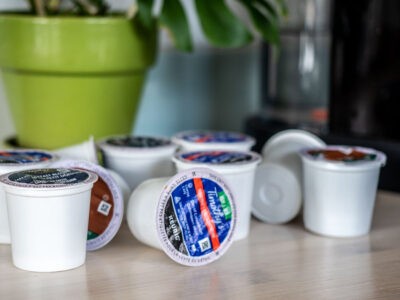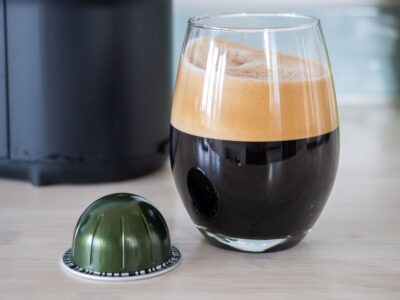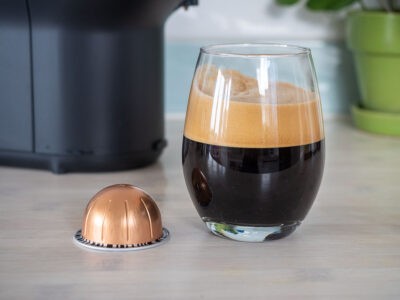Coffee Roasting, Recommendations
The 5 Best Home Coffee Roasters Of 2024
There is something special about roasting your own coffee at home. Not only does it allow you to experiment with different flavors and roast levels, but it also ensures your coffee is as fresh as possible.
The best home coffee roaster for you will depend on the amount of coffee you want to roast, the amount of control you want, and if you want a largely automated or manual process. We recommend,
- Nuvo Eco – A Basic Manual Roaster
- Mixfin –
- Behmor
- Dyvee – A fun steampunk-esk manual roaster
- Aillio Bullet – a fully-fledged automated small batch roaster
Why Listen To Us? Well, because we KNOW coffee! In fact, we make our own coffee, coffee machine cleaners, and reusable capsules which we've sold to over 41 countries. Our team ouf experts include Tristan (an engineer), Claire (a food writer) and Richy (a barista). So, whether you're looking for a recipe or repair guide, we've got you covered 💚
Table of Contents
Why Roast Your Own Coffee
Roasting your own coffee is a fun hobby that allows you to flex your creative muscles and enjoy a unique brew.
Here are other practical reasons to roast your coffee at home.
- Freshness: Freshly roasted beans reach their peak after about 3 days. That means you’ll enjoy a flavorful coffee because it has retained most of the natural oils.
- Control: Gives you greater control over the roast level and flavor profile. Whether you prefer light, medium, or dark roasts, you can achieve your ideal degree. Also, you can incorporate your favorite varieties and blends to brew a unique cup of coffee.
- Cost-effective: Roasting coffee can be a reasonable option in the long run. Roasted beans cost about $15 per pound (450g), while green beans cost between $6 and $12 per pound (450g).
A Rough Guide To Roasting Your Own Coffee
Here’s a rough guide to get you started with home roasting.
- Get your hands on green coffee beans: You can buy them online or at a specialty coffee shop.
- Preheat your roasting equipment: Preheat the roaster to its maximum temperature.
- Measure your beans: A good starting point is to use around 100g (3.5 oz) of beans for each batch.
- Start roasting: Add the green coffee beans and start the roasting process. Monitor the beans to ensure they’re evenly roasted.
- Cool the beans: Once you achieve your desired roast degree, remove them from the heat and cool them down quickly.
- Let the beans rest: It’s vital to let the beans rest for 48-72 hours. This allows the flavors to develop.
What To Look For In A Coffee Roaster
Knowing what to look for in a coffee roaster ensures you buy one that’ll fulfill your needs.
Below’s a comprehensive guide to aid you in your pursuit.
Different types of coffee roasters
- Drum roaster: Drum roasters use indirect heat to roast beans. The heat source can be electricity, gas, or wood. The inside of the machine has a cylindrical chamber that rotates. As it rotates, the beans come in contact with heat, which ensures an even roast.
- Hot air roasters: Similar to a popcorn maker, air roasters force heated air through a perforated plate under the coffee beans. As heat transfers to the beans, the beans circulate for an even roast.
Manual vs Automatic
Manual roasting is a more hands-on process, and the only aspect you can control is temperature. You’ll need to monitor the process and make adjustments to ensure the beans are roasted evenly.
Automatic roasters use built-in controls to regulate heat and airflow.
You can set the roaster to a specific temperature and let it run without needing to monitor it as closely. They can be a more convenient option, as they require less hands-on attention, making them an excellent choice if you are just starting out.
Capacity
Home roasters have a capacity of 75-250g to 800-1kg. When seeking the ideal capacity, ask yourself the following questions.
- How often are you going to roast?
- How much coffee do you need per week?
- Do you see yourself moving from home roasting to a professional level?
We recommend you choose a roaster that’s not too large or too small in capacity. Having flexibility allows you to experiment until you find a sweet spot that gives you perfectly roasted beans.
User interface
Most manual roasters have a dial that allows you to control temperatures. Others have a user-friendly control panel to control roast mode to cooling mode.
With an automatic roaster, you can employ a completely hands-off approach mode. You can also connect the roasters to a software, allowing you to make changes in real time and create repeatable profiles.
Smoke suppression
Beans get roasted to more than 200°C (392°F) and this process produces a lot of smoke.
Unless you have a strong vent to release the smoke, it’s best to invest in a device with an afterburner to reduce the amount of smoke emitted.
Cooling system
Because beans roast at 200°C (392°F) and above, they retain heat and may continue to roast way past the desired roast degree. For this reason, they have to be cooled below 40°C (104°F) within 4 minutes.
Some roasters will cool the beans within 4 minutes or fewer, while others have a longer cooling cycle.
It’s best to buy an appliance that cools within 4 minutes.
If, for whatever reason, you wind up with a roaster that doesn’t cool quickly, you can pour the beans into a metal colander and shake them around until they cool.
Keeping it clean
Cleaning the chaff off the roaster and its surroundings can be messy. (Most) Roasters come with a chaff collector so you don’t have to deal with an extra messy cooling tray.
You simply take the tray and empty the chaff into the bin or outside.
What’s best is you don’t have to perform a deep clean after every roast. A damp cloth wipe does the trick.
Also, choose a roaster with a removable, washable chamber.
Budget
Home roasters can range from $35 to over $1000. The more expensive roasters tend to offer more features and larger capacities.
Consider how much you are willing to spend and what features are most important to you.
The 5 Best Home Coffee Roasters Of 2024
Here are some of the best home coffee roasters available on the market.
1. Best for beginners: Nuvo Eco
Nuvo Eco is a ceramic coffee roaster that allows you to roast coffee the traditional way. You place the roaster over a heated gas or electric stove for approximately 15 minutes, and the result is evenly roasted beans.
This handheld roaster can roast up to 70g (2 oz) of beans at once. The visually appealing calabash-like design means you can use it as an ornamental piece on your kitchen top.
Best Beginner Roaster: The Nuvo Eco
- A ceramic coffee roaster
- Has a calabash-like design
- Can roast up to 70g (2 oz) of beans at once
- Can be placed over a heated gas or electric stove
2. Best budget option: Behmor
The Behmor roaster has both manual and automatic features. It has a large drum made of steel mesh and can roast up to 450g (16 oz) of beans.
Behmor has five preset roast profiles so you can roast unique blends with ease. When operating in automatic mode, you can choose the number of beans to roast, profile, drum speed, and roast degree.
The roaster has an easy-to-clean interior. You can vacuum the chaffs or dust them off with a dry cloth. It also has an afterburner to reduce smoke.
3. Best large capacity: Mixfin
This manual roaster can hold up to 750g (26 oz) of beans. It comes with a wide temperature range of 100-200°C (212-392°F) so you can achieve different roast levels by the turn of a dial.
The device has a built-in stirring rod that ensures an even distribution of heat for an even roast. It’s lined with non-stick Teflon for easy cleaning.
That’s not all.
You can also use it to roast nuts and popcorn.
Best Home Coffee Roasters: Mixfin
- Can hold up to 750g (26 oz) of beans
- With a wide temperature range of 100-200°C (212-392°F)
- Has a built-in stirring rod
- Lined with non-stick Teflon for easy cleaning
4. Best aesthetics: Dyvee
The Dyvee roaster has a sleek stainless steel design with a quartz glass drum so you can observe the entire roasting process. It also has a wooden handle to complete its elegant design.
Dyvee has a capacity of 400g (14 oz). But the manufacturer recommends roasting a batch of 200-300g (7-10 oz) of beans at a time for optimum results.
The roaster operates on a gas burner.
The only downside is its inefficient smoke suppressor; your roasting space is likely to get smokey. It’s best to use the roaster in a well-ventilated area or outdoors.
Most Aesthetic Roaster: Dyvee
- 400g (14 oz) capacity
- Operates on a gas burner
- Sleek stainless steel design with a quartz glass drum & wooden handle
- Best to use in a well-ventilated area or outdoors
5. Best high-end roaster: Aillio Bullet
If you’re ready to take your roasting game to the next level, the Aillio Bullet is worth investing in.
The roaster allows you to change up to 9 heat, drum, and fan speed settings. You can track the time, rate of rise, and temperature of the roast.
The roaster operates in both automatic and manual modes.
In automatic mode, the roaster reaches and maintains an ideal temperature until everything is fully warmed up. Once warmed, it enters charge mode (drops beans into the roaster) on its own.
When you achieve your desired roast level, you can switch to cooling mode with the press of a button. The roaster comes with a stainless steel cooling tray attached to the fan to get the beans to room temperature efficiently.
You can also connect the machine to roasting software. This allows you to make changes in real time or take advantage of the playback option to reproduce consistent profiles.
Best Premium Roaster: Aillio Bullet
- Operates in both automatic and manual modes
- Can connect the machine to roasting software
- Allows tracking the time, rate of rise & temperature of the roast
- With stainless steel cooling tray
Frequently Asked Questions
Q. What are examples of different coffee roasts?
The four different coffee roasts are:
Light: Light roasts are roasted at temperatures of 350-400°F (176-204°C). They are generally roasted just before the first crack, but some roasters stop when the first crack appears. They have a mellow body and are more acidic.
Medium: This degree is roasted between 400-430°F (204-221°C) and is achieved just before the second crack appears. Medium roasts are sweeter and have more body and balanced acidity.
Medium dark: Medium-dark roasts have a slightly shiny surface. They are roasted at 464-473°F (240-245°C) and the roasting process stops when the second crack appears. They have a bitter taste, with notes of dark chocolate and dark-roasted nuts.
Dark: The last roast degree, these beans are dark brown with a shiny surface. They are roasted between 465-480°F (240-249°C). Dark roasts have a heavy body and an intense ashy flavor.
Q. Is roasting your own coffee worth it?
We think that roasting your own coffee is totally worth it.
Here are some advantages of embarking on this craft.
Freshness: Freshly roasted beans reach their peak after about 3 days. That means you’ll enjoy the flavorful coffee because it has retained the natural oils.
Control: Gives you greater control over the roast level and flavor profile.
Cost-effective: Roasting coffee can be a reasonable option in the long run.
Q. How long does it take to roast coffee beans?
It can take between 8 to 20 minutes to roast coffee beans.
Conclusion
Investing in a home coffee roaster is a great way to experience the freshest, most flavorful coffee possible.
The home coffee roasters discussed in this article provide ease of use, affordability, and quality of results. From the beginner-friendly Nuvo Eco to the high-end Aillio Bullet, there is a roaster for every level of experience and budget.
Whether you are a home roaster looking to explore new flavors or a professional barista seeking to perfect your craft, a home coffee roaster is a worthy investment that will bring you endless satisfaction.











